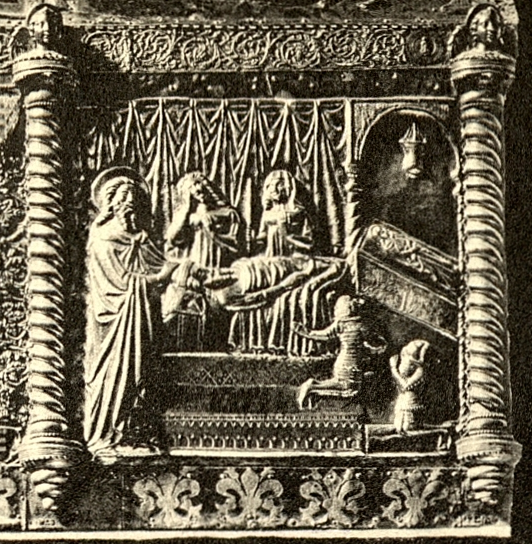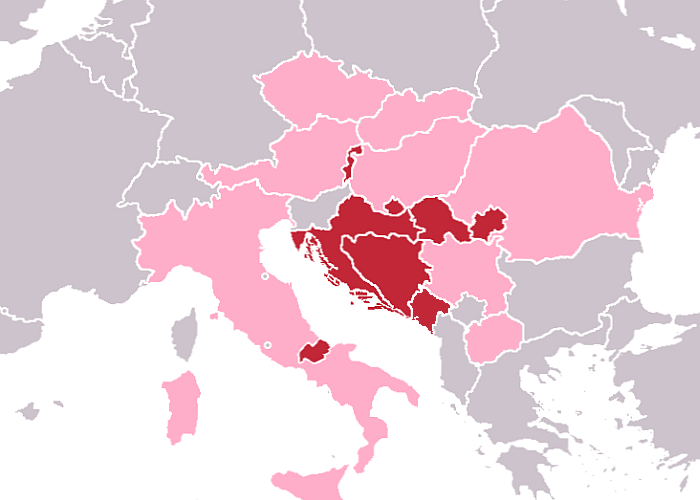|
Glamoč Fortress
Glamoč fortress ( Bosnian, Croatian and Serbian: ''Glamočka tvrđava'' / Гламочка тврђава) is a medieval fortress located on the north slopes of Staretina mountain just above town of Glamoč Glamoč ( sr-cyrl, Гламоч) is a town and municipality located in Canton 10 of the Federation of Bosnia and Herzegovina, an entity of Bosnia and Herzegovina. It is situated in southwestern Bosnia and Herzegovina, at the foothills of Staretin .... The construction of the fortress started as early as 14th century. Gallery File:Glamoč Fortress.JPG, Fortress File:Glamoč Fortress Tower.JPG, Tower References {{DEFAULTSORT:Glamoc Fortress Buildings and structures in Glamoč Castles in Bosnia and Herzegovina National Monuments of Bosnia and Herzegovina Forts in Bosnia and Herzegovina ... [...More Info...] [...Related Items...] OR: [Wikipedia] [Google] [Baidu] |
Glamoč
Glamoč ( sr-cyrl, Гламоч) is a town and municipality located in Canton 10 of the Federation of Bosnia and Herzegovina, an entity of Bosnia and Herzegovina. It is situated in southwestern Bosnia and Herzegovina, at the foothills of Staretina and Velika Golija mountains, and on the edge of the central part of the Glamoč Field. The municipality encompasses the town of Glamoč as a seat of the municipality and more than 50 villages and hamlets situated along the Field. It mainly covers an area of the historical and geographical region of Tropolje. Name During the Ottoman era the town was recorded as Biograd (White town), Belgradčik and Biogradaz. Geography Climate The climate of Glamoč is classified as an oceanic climate (''Cfb'' in Köppen climate classification system), near the boundary of the humid continental climate. Glamoč has four separate seasons. Summers are warm, and winters are cold, without a discernible dry season. Settlements * Babića Brdo * Bi ... [...More Info...] [...Related Items...] OR: [Wikipedia] [Google] [Baidu] |
Bosnia And Herzegovina
Bosnia and Herzegovina ( sh, / , ), abbreviated BiH () or B&H, sometimes called Bosnia–Herzegovina and often known informally as Bosnia, is a country at the crossroads of south and southeast Europe, located in the Balkans. Bosnia and Herzegovina borders Serbia to the east, Montenegro to the southeast, and Croatia to the north and southwest. In the south it has a narrow coast on the Adriatic Sea within the Mediterranean, which is about long and surrounds the town of Neum. Bosnia, which is the inland region of the country, has a moderate continental climate with hot summers and cold, snowy winters. In the central and eastern regions of the country, the geography is mountainous, in the northwest it is moderately hilly, and in the northeast it is predominantly flat. Herzegovina, which is the smaller, southern region of the country, has a Mediterranean climate and is mostly mountainous. Sarajevo is the capital and the largest city of the country followed by Banja Lu ... [...More Info...] [...Related Items...] OR: [Wikipedia] [Google] [Baidu] |
Circa
Circa is a word of Latin origin meaning 'approximately'. Circa or CIRCA may also refer to: * CIRCA (art platform), art platform based in London * Circa (band), a progressive rock supergroup * Circa (company), an American skateboard footwear company * Circa (contemporary circus), an Australian contemporary circus company * Circa District, Abancay Province, Peru * Circa, a disc-binding notebook system * Circa Theatre, in Wellington, New Zealand * Clandestine Insurgent Rebel Clown Army, a UK activist group * Circa News, an online news and entertainment service * Circa Complex Circa, formerly 1200 Figueroa, is a twin tower skyscraper complex at 1200 Figueroa Street in downtown Los Angeles, California. Ownership The developer is Hankey Investment Group. The complex is adjacent to the Pico/Chick Hearn Station of LA's ..., twin skyscrapers in Los Angeles, California * ''Circa'' (album), an album by Michael Cain * Circa Resort & Casino, a hotel in downtown Las Vegas {{Disamb ... [...More Info...] [...Related Items...] OR: [Wikipedia] [Google] [Baidu] |
Tvrtko I Of Bosnia
Stephen Tvrtko I ( sh-Latn-Cyrl, separator=" / ", Stjepan/Stefan Tvrtko, Стјепан/Стефан Твртко; 1338 – 10 March 1391) was the first king of Bosnia. A member of the House of Kotromanić, he succeeded his uncle Stephen II as Ban of Bosnia in 1353. As he was a minor at the time, Tvrtko's father, Vladislav, briefly ruled as regent, followed by Tvrtko's mother, Jelena. Early in his personal rule, Tvrtko quarreled with his country's Roman Catholic clergy, but later enjoyed cordial relations with all the religious communities in his realm. After initial difficulties – the loss of large parts of Bosnia to his overlord, King Louis I of Hungary, and being briefly deposed by his magnates – Tvrtko's power grew considerably. He conquered some remnants of the neighbouring Serbian Empire in 1373, after the death of its last ruler and his distant relative, Uroš the Weak. In 1377, he had himself crowned king of Bosnia and of Serbia, claiming to be the heir of S ... [...More Info...] [...Related Items...] OR: [Wikipedia] [Google] [Baidu] |
Grgur Stjepanić
Grgur ( sr-cyr, Гргур) is a Serbo-Croatian masculine given name, a variant of Greek ''Grēgorios'' (, la, Gregorius, English: Gregory) meaning "watchful, alert". It has been used in Serbian society since the Middle Ages. It may refer to: * Grgur Ninski (fl. 925-929), Croatian bishop * Grgur III Šubić Bribirski (d. 1235), Croatian nobleman * Grgur Kurjaković (fl. 1325), Croatian nobleman *Grgur Preljub (1312–1355), Serbian nobleman *Grgur Golubić (fl. 1347-1361), Serbian nobleman *Grgur Branković (1415–1459), Serbian nobleman *Grgur Vukosalić (d. 1436), Serbian nobleman *Grgur Radoš (b. 1988), Croatian footballer See also *Other Serbo-Croatian variants and diminutives include Grigorije, Grigor, Grga, etc. *Grgurević, surname *Grgić, surname *Sveti Grgur, an uninhabited island in Croatia *Grgurići Grgurići is a village in the city of Livno in Canton 10, the Federation of Bosnia and Herzegovina The Federation of Bosnia and Herzegovina is one of the two Po ... [...More Info...] [...Related Items...] OR: [Wikipedia] [Google] [Baidu] |
Stephen Ostoja Of Bosnia
Stephen OstojaHis name in Bosnian is rendered Stjepan Ostoja (), while in Croatian it's Stjepan Ostoja. In Serbian, he is called Stefan Ostoja (). ( sh-Latn-Cyrl, separator=" / ", Stjepan Ostoja, Стјепан Остоја; died September 1418) was King of Bosnia from 1398 to 1404 and from 1409 to 1418. Family connections He was a member of the House of Kotromanić, most likely son of Vladislaus and brother of King Stephen Tvrtko I. When duke Hrvoje Vukčić in 1416 died, King Ostoja divorced his old wife Kujava from the house of Radenović and married Hrvoje's widow Jelena Nelipčić the next year.John Van Antwerp Fine, Bosnian Institute; ''The Bosnian Church: Its Place in State and Society from the Thirteenth to the Fifteenth Century'', Saqi in association with The Bosnian Institute, 2007 Jelena Nelipčić was the sister of Prince Ivan III Nelipac from the Croatian noble Nelipić (Nelipac) family. That way Ostoja inherited most of Hrvoje's lands. Rise to power Ostoja was ... [...More Info...] [...Related Items...] OR: [Wikipedia] [Google] [Baidu] |
Pavao Maštrović Klešić , a Portuguese name
{{disambig ...
Pavao may refer to: * Pavao (given name), a Croatian name * Pavão (other) Pavão may refer to: Places * Pavão, Minas Gerais, a municipality in Brazil *Vila Pavão, Espírito Santo, a municipality in Brazil * Figueira Pavão, a settlement in the island of Fogo in Cape Verde People * Pavão (footballer, born 1947), Portu ... [...More Info...] [...Related Items...] OR: [Wikipedia] [Google] [Baidu] |
Bosnian Language
Bosnian (; / , ) is the standardized variety of the Serbo-Croatian pluricentric language A pluricentric language or polycentric language is a language with several interacting codified standard forms, often corresponding to different countries. Many examples of such languages can be found worldwide among the most-spoken languages, inc ... mainly used by ethnic Bosniaks. Bosnian is one of three such varieties considered official languages of Bosnia and Herzegovina, along with Croatian language, Croatian and Serbian language, Serbian. It is also an officially recognized minority language in Croatia, Serbia, Montenegro, North Macedonia and Kosovo. Bosnian uses both the Gaj's Latin alphabet, Latin and Serbian Cyrillic alphabet, Cyrillic alphabets, with Latin in everyday use. It is notable among the variety (linguistics), varieties of Serbo-Croatian for a number of Arabic, Persian language, Persian and Turkish language, Turkish loanwords, largely due to the language's interacti ... [...More Info...] [...Related Items...] OR: [Wikipedia] [Google] [Baidu] |
Croatian Language
Croatian (; ' ) is the standardized variety of the Serbo-Croatian pluricentric language used by Croats, principally in Croatia, Bosnia and Herzegovina, the Serbian province of Vojvodina, and other neighboring countries. It is the official and literary standard of Croatia and one of the official languages of the European Union. Croatian is also one of the official languages of Bosnia and Herzegovina and a recognized minority language in Serbia and neighboring countries. Standard Croatian is based on the most widespread dialect of Serbo-Croatian, Shtokavian, more specifically on Eastern Herzegovinian, which is also the basis of Standard Serbian, Bosnian, and Montenegrin. In the mid-18th century, the first attempts to provide a Croatian literary standard began on the basis of the Neo-Shtokavian dialect that served as a supraregional ''lingua franca'' pushing back regional Chakavian, Kajkavian, and Shtokavian vernaculars. The decisive role was played by Croatian Vukovi ... [...More Info...] [...Related Items...] OR: [Wikipedia] [Google] [Baidu] |
Serbian Language
Serbian (, ) is the standardized variety of the Serbo-Croatian language mainly used by Serbs. It is the official and national language of Serbia, one of the three official languages of Bosnia and Herzegovina and co-official in Montenegro and Kosovo. It is a recognized minority language in Croatia, North Macedonia, Romania, Hungary, Slovakia, and the Czech Republic. Standard Serbian is based on the most widespread dialect of Serbo-Croatian, Shtokavian (more specifically on the dialects of Šumadija–Vojvodina dialect, Šumadija-Vojvodina and Eastern Herzegovinian dialect, Eastern Herzegovina), which is also the basis of Croatian language, standard Croatian, Bosnian language, Bosnian, and Montenegrin language, Montenegrin varieties and therefore the Declaration on the Common Language of Croats, Bosniaks, Serbs, and Montenegrins was issued in 2017. The other dialect spoken by Serbs is Torlakian dialect, Torlakian in southeastern Serbia, which is transitional to Macedonian lang ... [...More Info...] [...Related Items...] OR: [Wikipedia] [Google] [Baidu] |
Staretina
Staretina is a mountain in the municipality of Livno, Bosnia and Herzegovina Bosnia and Herzegovina ( sh, / , ), abbreviated BiH () or B&H, sometimes called Bosnia–Herzegovina and often known informally as Bosnia, is a country at the crossroads of south and southeast Europe, located in the Balkans. Bosnia and H .... It has an altitude of . See also * List of mountains in Bosnia and Herzegovina References Mountains of Bosnia and Herzegovina {{Canton10-geo-stub ... [...More Info...] [...Related Items...] OR: [Wikipedia] [Google] [Baidu] |
Buildings And Structures In Glamoč
A building, or edifice, is an enclosed structure with a roof and walls standing more or less permanently in one place, such as a house or factory (although there's also portable buildings). Buildings come in a variety of sizes, shapes, and functions, and have been adapted throughout history for a wide number of factors, from building materials available, to weather conditions, land prices, ground conditions, specific uses, prestige, and aesthetic reasons. To better understand the term ''building'' compare the list of nonbuilding structures. Buildings serve several societal needs – primarily as shelter from weather, security, living space, privacy, to store belongings, and to comfortably live and work. A building as a shelter represents a physical division of the human habitat (a place of comfort and safety) and the ''outside'' (a place that at times may be harsh and harmful). Ever since the first cave paintings, buildings have also become objects or canvasses of much artisti ... [...More Info...] [...Related Items...] OR: [Wikipedia] [Google] [Baidu] |


